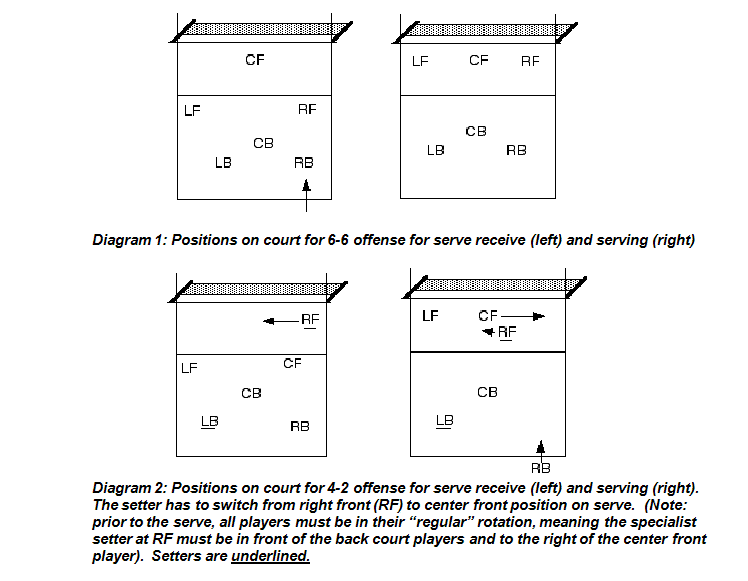|
RADIBALL: A GREAT WAY TO DEVELOP VOLLEYBALL
SKILLS, TACTICS, AND GAMES!
written
by Peter
Rattigan, Associate Professor, Rowan
University, Glassboro, NJ
 Elementary
physical educators are familiar with
the game of Newcomb
Ball, a popular lead up team game
loosely based on volleyball. Usually
half of the class is placed on one side
of a volleyball net, and the other half
of the class is placed on the other
side. The rules are few: the ball is
thrown over the net to begin the game;
players are to catch the ball and pass
(i.e., throw or toss) the ball to someone
else on their team, who may in turn
throw to another teammate. Elementary
physical educators are familiar with
the game of Newcomb
Ball, a popular lead up team game
loosely based on volleyball. Usually
half of the class is placed on one side
of a volleyball net, and the other half
of the class is placed on the other
side. The rules are few: the ball is
thrown over the net to begin the game;
players are to catch the ball and pass
(i.e., throw or toss) the ball to someone
else on their team, who may in turn
throw to another teammate.
The third throw
must go over the net, as in regular
volleyball. Scoring is similar to regulation
volleyball. Often there are more than
six players per side, so in order to
allow everyone to “serve”
and be equally involved in the game,
teachers may have a front court and
back court group, for example, and switch
them once every player in the back court
has "served."
I first read
about and used this game as an elementary
physical educator in the early 1990s.
Although my classes seemed to enjoy
it, I felt that it had many limitations,
including:
- As in many similar massed team
games, few students got to contact
the ball.
- While students
utilized some catching and throwing,
they did not get to use or apply any
actual volleyball skills.
- There was
no opportunity to use even the most
rudimentary volleyball team strategy.
- After catching
the ball, many students seemed to
enjoy possession (with everyone yelling
at them to throw the ball their way),
and held on to it far too long, enjoying
their 15 minutes of fame.
- The game
was far too removed from actual volleyball
(with the exception of the net) for
students to transfer any knowledge
or skill from one game to the other.
Having said that, Newcomb Ball had
one great advantage over volleyball
as a game for younger children: every
child had a realistic chance of getting
to the ball because they could catch
it. Therefore, most children could feel
competent at this game. The fact remained,
however, that they were not practicing
or applying volleyball related skills.
Newcomb Ball was, for me, a low organized
game that could be used as a quick opening
activity or as a way to practice throwing
and catching in a group. (Although,
with one ball and a group of perhaps
25 students, I found the inclusiveness
of the game wanting also.)
In order to utilize the practical benefit
of Newcomb Ball while addressing all
the limitations listed above, I developed
a game I called Modified Newcomb Ball,
and which I now call Radiball.
It is both a radical departure from
the rules of Newcomb Ball, and radical
in itself in that it can be used at
any grade level according to the skill
of the players and the purpose of the
lesson.
What is Radiball?
Well, in fact it is very similar to
Newcomb Ball in the sense that players
are allowed to catch the ball. Where
it differs is what happens after each
catch. In Radiball, after catching the
ball, players must pass the ball to
a teammate over the net with a forearm
pass, overhead pass, or hit/spike. The
way they do this is to, immediately
after the catch, toss the ball to themselves
and perform the pass or hit necessary
for the occasion. There are three basic
versions of the game: One catch, two
catch, and three catch Radiball.
Three catch Radiball is what I have
my younger classes play. I teach them
basic versions of the overhand serve,
forearm pass, and overhead pass using
modified equipment from a self-feed
technique and from a partner-feed technique.
By the time they are in third grade,
the students are able to do all these
skills from a self-feed in a game. For
instance, a rally will start with an
overhead serve (If I have a second grade
class for example, a floater ball is
served, the server being allowed to
serve from close to the net). A player
on the receiving team will catch the
ball, self toss and pass (forearm or
overhead) to another player, who will
do the same for a player close to the
net (i.e., a front court player). This
player is to catch the ball, toss it
and hit it over (same action as the
overhead serve).
For elementary children, I have a three
second possession rule; players may
hold the ball after a catch for no more
than three seconds before they pass
or hit it. This saves the time wasting,
“I love all this attention so
I think I’ll keep the ball longer”
tendencies that occur in the absence
of this rule.
By third or fourth grade, some of my
students are ready for the two catch
version. At this time I let them jump
and hit the ball over the net. However,
if they do a jump and hit they may not
catch the ball first. This is voluntary
at first, then usually mandatory by
the end of fourth grade. The first pass
should go to the center front player
so that they can catch and set up another
front court player for a spike.
Usually by fifth grade, I have introduced
one catch Radiball. The first or second
pass/contact may be preceded by a catch.
Sometimes I enforce it on the serve
receive (to get the best chance of controlling
the pass in order to practice set and
spike within the game), and sometimes
on the second pass (set). The latter
option allows for a realistic serve
receive setting, but enables the setter
to get to the ball and have an excellent
chance to make a set under control for
the spiker to hit. Sometimes I let the
teams choose which contact is preceded
by a catch. Now they have to figure
out on the fly whether they can catch
or not (if the serve is caught, the
pass cannot be, for example).
In sixth grade I usually provide options
such as regular volleyball with modified
equipment (lower net, floater or foam
ball). However, they still have the
one catch option also – for example,
if I want them to use regulation ball
and court, I will use one catch Radiball.
In seventh grade I may refine the sixth
grade rules a little, or play regular
volleyball, depending on the classes.
However, I want my classes by this time
to play real volleyball, including sets
and spikes, and so I will reintroduce
one catch when necessary to optimize
this. I may introduce blocking and defense
here, in which case I will go back to
one catch until they are comfortable
with the new skills.
The pace at which more sophisticated
volleyball game skills and tactics are
introduced depends on the skill of the
students and the amount of time the
teacher has with them. In the school
I taught at in Minnesota in the 1990s,
there was limited physical education
at the high school level, so taught
the 4-2 offense to my 7th and 8th graders,
using 1 and 2 catch Radiball. In New
Jersey, where I teach in college and
introduce Radiball in my methods classes,
I tell my teacher candidate students
that they will have their students for
longer (all four years in high school),
so they can develop at a slower pace
and may be able to use only 1 catch
Radiball when teaching a new skill or
strategy. The key is that by increasing
students’ self efficacy and by
enabling the game to be “frozen”
in time, advanced skills and strategies
can be taught in real time, during a
game.
By eighth grade classes are ready to
go from the 6-6 offense (everybody hits
when at left or right front, everybody
sets when at center front). By now,
both my students and I know who the
best setters and hitters are on each
team, so they can specialize (volleyball
is the only team sport in which I have
students “specialize,” due
to the unique skill requirements of
the game and its tactical possibilities).
At this point I will go to one catch
Radiball (usually for the second contact)
to give the setter time to switch into
position and set under control and with
optimum precision. The diagrams below
indicate 6-6 and 4-2 offenses and how
the front court players move in order
to get the designated setter into position.

At high school level, I still use Radiball
in order to develop team and individual
skills within the game. For example,
if teams are not setting up spike attacks,
I will go to one catch Radiball to maximize
offense play and counterattacks. If
my classes are able to play at a decent
level, I then go on to advanced skills
and strategies my high schoolers might
never have thought possible (two person
blocking, deep and short defensive cover,
different types of set, different spike
plays, even a different offense such
as a 5-1 or an International 4-2. I
even teach back-sets to my eighth graders.
A Radiball back-set is quite easy for
many of them…). Each time, I will
usually start with one touch Radiball
until they are able to perform (if at
all) these advanced skills and strategies
in a regulation game. Needless to say,
this all depends on the setting and
the students. In addition, one could
always revert to two catch Radiball…
Throughout this whole evolution of
the game of volleyball through use of
the game of Radiball, we use regular
volleyball teams, positions and rotations
(e.g., 6 on 6, three up and three back,
clockwise rotation prior to serving).
I adjust the courts to smaller size
if necessary. I may use one or two subs
who rotate in on serve (I often have
a two or three serve rule to speed up
rotation if subs are being used). Since
the purpose is for my classes to play
volleyball at a competent level, I keep
teams, positions, and courts as close
to the regular configuration as possible.
In a "regular" volleyball
game, even in high school, there may
be no hits/spikes at all; utilizing
Radiball rules, I frequently have many
rallies that contain the classic sequence
of any good volleyball game: pass, set,
spike. Counterattacks from good defense
of a spike are also not uncommon. Of
course, the ultimate goal is to achieve
this within a regular volleyball game.
Radiball, in the meantime, provides
an enjoyable and practical alternative
and a highly effective way to slow down
the action in order to refine skills
and strategies within the game. The
catch and self-feed "freezes"
time for up to three seconds, and it
is surprising what can be accomplished
in those three seconds (for example,
the setter can tell the spikers to move
back for their approach, something that
rarely happens in a "regular"
volleyball game).
I have introduced Radiball to teachers
and teacher candidates at workshops.
Groups of perfect strangers have played
some great rallies with many attacks
and counterattacks. They have really
enjoyed it and want to keep playing.
Try Radiball with your students - you
might be surprised at what they can
accomplish!
|



